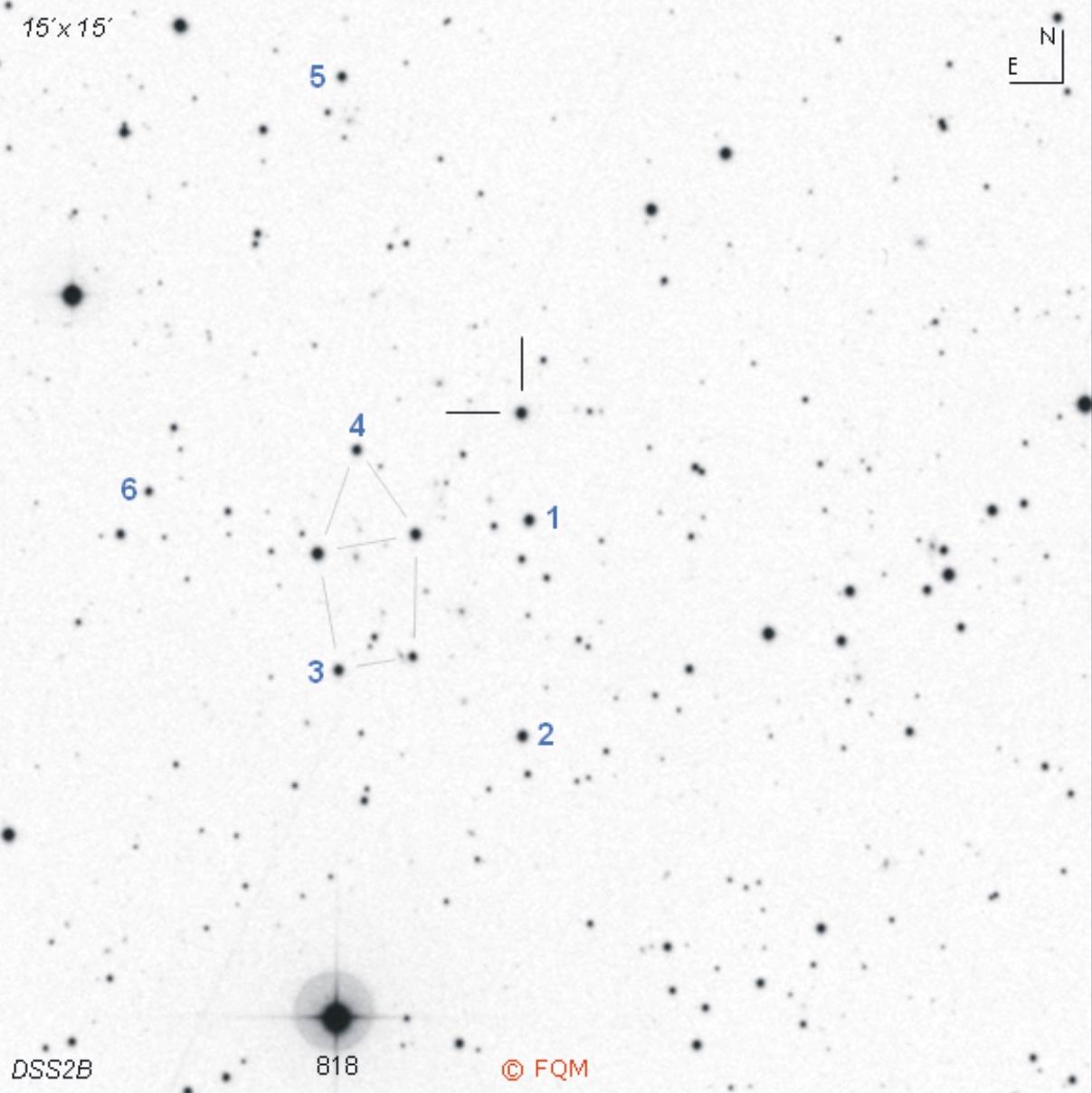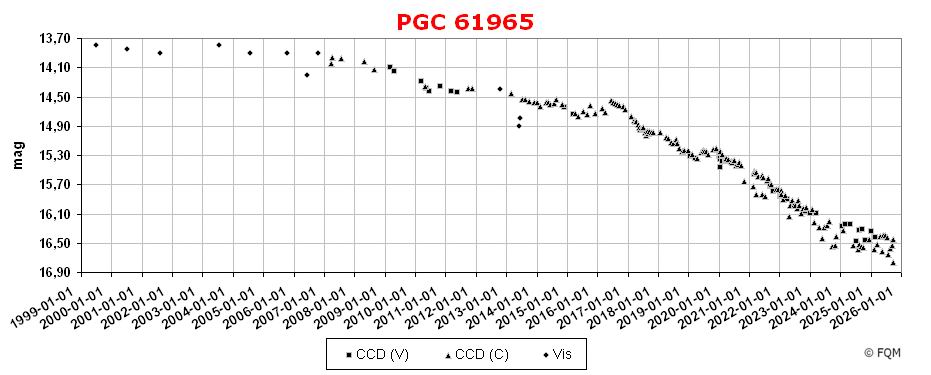
| Frankfurt Quasar Monitoring |
| PGC
61965 |
| Cross-Identifications |
RX J1830.3+7312, 2MASS J18302317+7313107 2MASSi J1830231+731310, IRAS F18315+7310 GALEXASC J183023.19+731310.6, LEDA 61965 1RXS J183022.3+731300, QSO B1831+731 WISEA J183023.15+731310.6 |
| Equat. coordinates | RA 18 30 23.3 DE +73 13 10 (J2000) |
| Constellation | Draco |
| Type |
QSO |
| Redshift | z=0.123 |
|
Distance
(2)
(3) |
491 Mpc |
| Total mag range (mv) (4) (5) | 13.8 - >20 |
| Catalog Magnitude (1) | 15.5 |
| Absolute Magnitude (1) | -23.9 MB |
| Light Travel-Time (2) | 1.512 × 109 yrs |

Comparison stars
| star | B | V |
| 1 | 14.853 (0.008) | 13.951 (0.000) |
| 2 | 14.798 (0.015) |
14.050 (0.000) |
| 3 | 15.094 (0.011) |
14.150 (0.017) |
| 4 | 15.267 (0.011) |
14.351 (0.012) |
| 5 | 15.605 (0.000) | 14.675 (0.017) |
| 6 |
16.283 (0.051) | 15.277 (0.000) |

| PGC
61965
(QSO B1831+731=1831+731) is a bright
quasar in northern Draco, only 50´NE of 3.5-mag Chi (44) Draconis. This
object was discovered by Zwicky
(1968) as a faint member of the remote galaxy cluster ZwCl 1831.4+7310
= ZW 8376. A close look at old POSS plates revealed PGC 61965 as a
faint 18-19 mag compact
galaxy. Dramatic changes were recognized by P. Wild in 1975 (IAU Circ.
2791). He found the object to be variable in the optical between 15 mag
and less than 20-21 mag. Between 1960 and 1965, it could not be
detected photographically. Then in 1975, he
reported an optical outburst of 15.0-15.5 mag. Wild
described the
galaxy PGC
61965
as "compact,
almost stellar". Based
on the
strong variability, Wills initially assumed that this object might be a BL
Lacertae-type object.
However, follow-up
spectroscopic investigations revealed a Seyfert
1-spectrum, which led to the quasar classification. Due
to P.
Wild´s
investigations, PGC 61965 is
also dubbed the
"Wild's
Variable Object". In
1971, the quasar was identified as a radio source by the Texas Radio
Astronomy Observatory. PGC 61965 was also detected by the International
Ultraviolet Explorer IUE (1978-1987), in the infrared by both IRAS and the
2MASS-Survey, and finally as an X-ray source by ROSAT (RX). Quasar PGC 61965 is a large amplitude variable object with a total range of about 6 magnitudes in the optical (14 - 20+ mag). Observations by the Frankfurt Quasar Monitoring programme have shown the quasar as a bright stellar object ranging between 13.8 m and 15.8 m (1999-2022), with a continuous decline in apparent brightness since about 2008. Quasar PGC 61965 is located in northern Draco, only 50´NE of 3.5-mag Chi Draconis (44 Dra). The small asterism, a few arcminutes SE of the quasar, reminded the author of the constellation “Cepheus”, so he christened this star pattern the “Little Cepheus”, which makes the identification of PGC 61965 very easy in both the eyepiece and the CCD frame. Nowadays, visual observers need at least an 14- to 16-inch telescope to spot this very faint stellar object. Even with large aperture telescopes this quasar remains a stellar object. CCD observers, as well as visual observers, shall use the comparison stars given above. Deep CCD images also reveal some tiny, faint galaxies around. Most of them are members of the host galaxy cluster mentioned above. Some of them can also be seen in the finding chart above. ____________
Two pretty bright galaxies can be observed nearby: The first one is NGC 6643, some 1.5° NW. This 11.7-mag Sc-spiral is elongated 3.7´× 1.8´. By slewing the telescope only 27´ to the west of the QSO position, observers find NGC 6654, a SB0a-type spiral of 12.8-mag with an apparent diameter of 2.6´× 2.1´. Another bright source of quasi-stellar photons is BL Lac object 3C 371, a 14-mag object at a distance of about 0.6×109 light-years, 3.8° SW of PGC 61965. |
| Douglas, J.N., Bash, F.N., et al. 1973, AJ, 78, 1; First Results from the Texas Interferometer: Positions of 605 Discrete Sources. Fouque, P., Durand, N., et al. 1992, Observatoires de Lyon et Paris-Meudon, Vol.1, 1; Catalogue of Optical Radial Velocities. Hewitt, A., Burbidge, G. 1991, ApJS, 75, 297; An Optical Catalog of Extragalactic Emission-Line Objects similar to Quasi-Stellar Objects. Karge, S.; Helle Quasare für 8- bis 10-Zoll Teleskope. Ein Beobachtungsführer zur visuellen Beobachtung von Quasaren und BL Lacertae Objekten; Frankfurt 2005. Kobayashi, Y., Sato, S., et al. 1993, ApJ, 404, 94; An Infrared Study of Hot Dust in Quasars using Prism Spectrophotometry. Lanzetta, K.M., Turnshek, D.A., Sandoval, J. 1993, ApJS, 84, 109; Ultraviolet Spectra of QSOs, BL Lacertae Objects, and Seyfert Galaxies. Pica, A.J, Smith, A.G., et al. 1988, AJ, 96, 4; Long-Term Optical Behavior of 144 Compact Extragalactic Objects: 1969-1988. Smith, A.G., Nair, A.D. 1995, PASP, 107, 863; Timescales of Long-term Optical Base-level Fluctuations in Three Classes of AGN. Stirpe, G.M. 1990, A&AS, 85, 1049; Broad Emission Lines in Active Galactic Nuclei. I - An atlas of H-alpha and H-beta profiles. Véron-Cetty, M.-P., Véron, P. 2001, A&A 374, 92; A Catalogue of Quasars and Active Nuclei: 10th edition. Véron-Cetty, M.-P., Véron, P. 2003, A&A 412, 399; A Catalogue of Quasars and Active Nuclei: 11th edition. Véron-Cetty, M.-P., Véron, P. 2006, A&A 455, 776; A Catalogue of Quasars and Active Nuclei: 12th edition. Véron-Cetty, M.-P., Véron, P. 2010, A&A 518, 10; A Catalogue of Quasars and Active Nuclei: 13th edition. Wild, P. 1975, IAU Circ., No. 2791; BL Lacertae-Type Object. Wills, B.J., Wills, D. 1979, ApJS, 41, 689; Spectroscopy of 125 QSO Candidates and Radio Galaxies. Wills, D. 1975, IAU Circ., No. 2820; Wild's Variable Object. Zwicky, F., Herzog, E.; Catalogue of Galaxies and of Clusters of Galaxies; 1968, Vol. IV, Pasadena: California Institute of Technology. |
| Link: APASS |
| home |